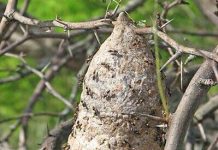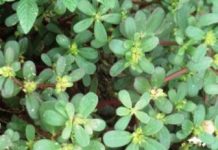Scientific name: Abroma augusta (L.) L.f.
Family: Sterculiaceae
Synonym: Abroma alata Blanco, Abroma elongata Lam.
Bengali/Vernacular name: Ulatkambal, Ulutkambal, Tambol.
Tribal name: Gach chola (Chakma), Polumaoeba (Chak), Daiya (Garo).
English name: Devil’s cotton.
Description of the plant: A large spreading shrub, or a small tree, with fibrous bark and irritant hairs. It grows up to 2.5 m tall with hairy branches. Leaves are alternate, ovate-oblong, long-pointed, with a heart-shaped base, margin unevenly toothed. Flowers are maroon, about 5 cm across, solitary, axillary, pendulous. Sepals are lance-shaped, fused at base. Petals are 5, which soon fall off. Capsule is papery, 5-winged, cut-off at the tip.

Plant parts used: Leaf, stem, bark, and root.
Ethnomedicinal uses: An infusion is made with the fresh leaves and stems of the plant are taken for the treatment of leucorrhoea and dysmenorrhoea.
Leaves and stems of the plant are used to treat menstrual disorders.
Infusion of fresh stems and leaves in cold water is used for the treatment of gonorrhoea.
Fresh juice extracted from the roots of the plant is taken three times a day (two tea spoons amount each time) until the fever is cured.
The bark and roots of the plant is used to treat stomachache, diabetes, and dermatitis.
Distribution: This plant is found nearly in all the districts under planted condition.
Is this plant misidentified? If yes, please tell us….















… [Trackback]
[…] Information to that Topic: natureinfo.com.bd/abroma-augusta/ […]